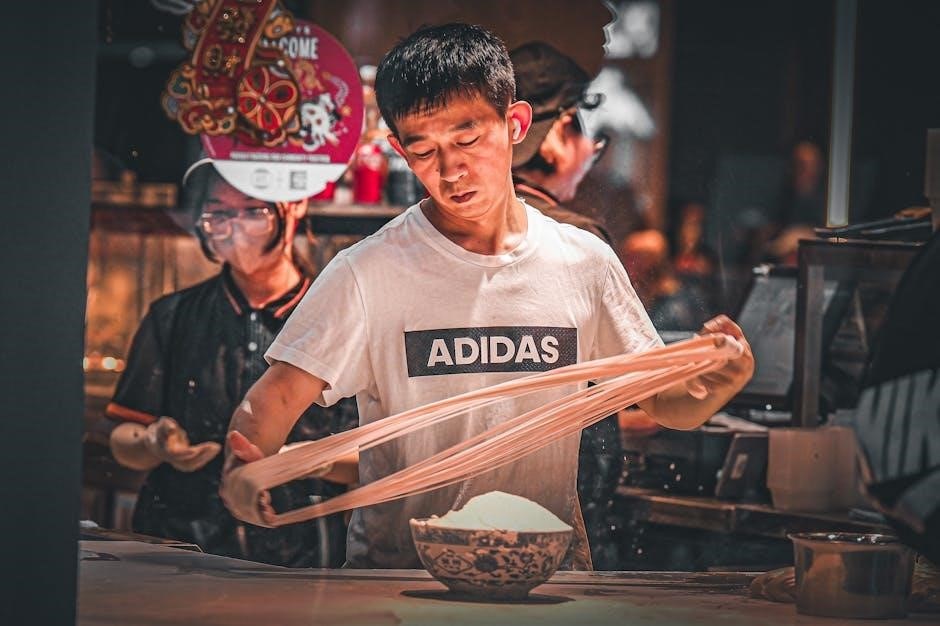
the making of asian america pdf
The Making of Asian America by Erika Lee offers a comprehensive history of Asian Americans, tracing their journeys from the 16th century to modern times. The book explores their contributions, challenges, and the evolution of their identity, providing a rich narrative that fills gaps in American history. It is praised for its thorough research and accessible writing, making it a vital resource for understanding the Asian American experience.
1.1 The Significance of Erika Lee’s Work
Erika Lee’s work is significant for its comprehensive and nuanced exploration of Asian American history, filling gaps in traditional narratives. Her research, drawing from sources like immigrant autobiographies and historical records, provides a detailed account of Asian American experiences. Lee’s accessible writing makes the history approachable, emphasizing the importance of understanding this diverse and evolving community in America.
1.2 Overview of the Book’s Content
The Making of Asian America explores the diverse experiences of Asian Americans, from early migrations to contemporary challenges. It delves into the journeys of various groups, including Chinese, Japanese, Koreans, South Asians, and Filipinos, highlighting their struggles and contributions. The book bridges historical gaps, offering insights into identity, exclusion, and resilience, while shedding light on the rich tapestry of Asian American life in the United States.

Historical Context of Asian American Migration
The origins of Asian American migration trace back to the 16th century with the Spanish Empire, followed by pivotal 19th-century movements like Chinese laborers in California, shaping the foundation of Asian America’s diverse identity and growth.
2.1 Early Migration Patterns in the 16th Century
The 16th century marked the beginning of Asian migration to the Americas, facilitated by the Spanish Empire. Asian laborers and traders traveled across the Pacific on Spanish galleons, establishing early connections between Asia and the Americas. These movements laid the foundation for the diverse Asian American communities that would develop in the centuries to come.

2.2 The Role of the Spanish Empire in Asian Migration
The Spanish Empire initiated Asian migration in the 16th century, transporting laborers and traders via galleons to expand their influence. These early migrants contributed to the cultural and demographic landscape of the Americas, setting the stage for future Asian migrations and integration into American society.
2.3 The Impact of Economic Opportunities and War
Economic opportunities and war significantly influenced Asian migration, with laborers seeking refuge and prosperity. The 19th century saw Chinese laborers arrive in California, driven by economic needs, while later waves included refugees escaping conflicts in Southeast Asia. These factors shaped the diverse origins and experiences of Asian immigrants, contributing to the complexity of Asian America’s formation.

The Age of Mass Migration and Exclusion
This period saw the influx of Asian laborers, particularly Chinese in California, driven by economic opportunities. Exclusion laws like the Chinese Exclusion Act of 1882 followed, halting immigration and shaping the era of exclusion, while Japanese, Korean, and South Asian immigrants later arrived, adding to the diverse tapestry of Asian America.
3.1 Chinese Laborers in 19th-Century California
Chinese laborers arrived in California during the 19th century, driven by economic opportunities and fleeing war; They played a crucial role in building infrastructure, including the transcontinental railroad. Despite their contributions, they faced severe discrimination, leading to the Chinese Exclusion Act of 1882, which halted Chinese immigration and marked the beginning of exclusionary policies targeting Asian immigrants.
3.2 The Exclusion Laws and Their Effects
The Exclusion Laws, such as the Chinese Exclusion Act of 1882, severely impacted Asian immigrants by halting their entry and restricting their rights. These laws led to a significant reduction in Asian immigration and created a racial hierarchy, marginalizing Asian communities and shaping their experiences for generations. They also set precedents for future exclusionary policies targeting other Asian groups.
3.4 The Arrival of Japanese, Korean, and South Asian Immigrants
The late 19th and early 20th centuries saw waves of Japanese, Korean, and South Asian immigrants arriving in America, driven by economic opportunities and fleeing political unrest. They faced similar challenges to earlier Asian groups, including exclusion laws and discrimination, yet contributed significantly to industries like agriculture and small businesses, enriching the cultural fabric of the United States.

The Making and Remaking of Asian America
The Making of Asian America explores the evolution of Asian American identity through historical records, including the first world atlas and immigrant autobiographies, revealing their resilience and contributions.
4.1 The Role of Immigrant Autobiographies and Historical Records
Immigrant autobiographies and historical records provide vivid insights into the Asian American experience, revealing personal struggles, cultural adaptation, and contributions. These documents, including the first world atlas and newspaper accounts, humanize history, offering a deeper understanding of the challenges and triumphs of Asian immigrants in shaping their identities and communities in America;
4.2 The First World Atlas and Its Significance
The first world atlas, printed in 1570, plays a crucial role in understanding early Asian migration to the Americas. It provides historical context by mapping global connections and influencing perceptions of Asia. This atlas, alongside other records, helps trace the origins of Asian American history, offering insights into the journeys and settlements that shaped their identity and contributions to the United States.
4.3 Newspaper Accounts and Their Influence
Newspaper accounts have played a vital role in documenting Asian American experiences, shaping public perception, and influencing policies. These records reflect societal attitudes toward Asian immigrants, highlighting their challenges and contributions. By examining these accounts, historians gain insights into the lived realities of Asian Americans, making them a valuable resource for understanding their historical and cultural significance in the United States.
The Role of Asian Americans in Shaping Modern America
Asian Americans are reshaping modern America as the fastest-growing demographic, driving innovation, and enriching cultural diversity. Their contributions span business, technology, arts, and politics, fostering a more inclusive society.
5.1 The Fastest Growing Group in the United States
Asian Americans are the fastest-growing racial group in the U.S., with their population nearly doubling since 2000. This growth reflects increased immigration and a higher birth rate, reshaping demographics and influencing cultural, economic, and political landscapes. Their contributions span industries, enriching American society and fostering a more diverse nation.
5.2 The Changing Face of America
Asian Americans are reshaping the demographic and cultural landscape of the U.S., bringing diverse traditions, languages, and perspectives. Their rapid growth and integration are fostering a more inclusive society, challenging stereotypes, and enriching American culture. This transformation highlights the nation’s evolving identity and the vital role Asian Americans play in its future development and progress.
5.3 The Contribution of Asian Americans to American Life
Asian Americans have profoundly enriched American life through cultural, economic, and social contributions. Their influence spans innovation, education, arts, and politics, fostering diversity and innovation. From business leadership to cultural expressions, their impact helps shape the nation’s identity, making them indispensable to the fabric of American society and its continued progress in a globalized world.

The Evolution of Asian American Representation in Media
The portrayal of Asian Americans in media has evolved from caricatures to authentic representations, with the 21st century seeing increased diversity and the rise of the GUAA movement.
6.1 From Caricatures to Authentic Portrayals
Asian Americans have transitioned from being portrayed as caricatures in early media to more authentic representations. Historical stereotypes gave way to diverse, genuine depictions, reflecting the complexity of their experiences. This shift has fostered greater understanding and representation, highlighting the importance of accurate storytelling in shaping public perception and identity.
6.2 The Shift in 21st-Century Media Representation
The 21st century has seen a significant shift in Asian American media representation, moving toward more diverse and authentic storytelling. Streaming platforms and social media have amplified Asian voices, challenging stereotypes and showcasing complex identities. This era emphasizes inclusivity, reflecting the multifaceted experiences of Asian Americans and fostering cultural understanding on a broader scale.
6.3 The Growing Up Asian American (GUAA) Movement
The Growing Up Asian American (GUAA) movement highlights the marginalized experiences of Asian Americans, particularly women, through digital platforms like YouTube. It offers authentic narratives, challenging stereotypes and amplifying diverse voices. This movement fosters a sense of community and validates individual journeys, promoting cultural understanding and representation beyond traditional media.

The Role of Women in Asian American History
Asian American women have played pivotal roles in shaping cultural, social, and political landscapes, despite facing marginalization. Their stories highlight resilience, contributions, and the ongoing struggle for visibility and equality.
7.1 The Marginalized Experiences of Asian American Women
Asian American women have historically faced exclusion, stereotyping, and invisibility, often marginalized by both race and gender. Their stories reveal resilience amid systemic oppression, highlighting contributions to migration, labor, and community survival, despite being overshadowed in dominant narratives.
7.2 The Portrayal of Women in Media and Literature
Asian American women have often been stereotyped or excluded in media and literature, historically portrayed as submissive or exotic. However, modern narratives are shifting, offering more authentic and diverse representations. Literary works and media now highlight their complex identities, challenging stereotypes and amplifying their voices, reflecting their true contributions and experiences in American society.
7.3 The Growing Visibility of Asian American Women
Asian American women are gaining increased visibility, challenging historical marginalization through media, literature, and advocacy. Their stories, once overlooked, are now central in narratives about identity, resilience, and contribution. The Growing Up Asian American (GUAA) movement and social media platforms amplify their voices, fostering greater representation and recognition in both public discourse and cultural expression.
The Impact of Racial Tension and Discrimination
Racial tension and discrimination have profoundly shaped Asian American experiences, from exclusion laws to recent hate crimes. Education plays a crucial role in combating stereotypes and fostering understanding, while collective efforts are needed to address ongoing challenges and promote inclusivity.

8.1 The Effects of Racial Socialization Practices
Racial socialization practices have profoundly influenced Asian Americans, shaping their identity and resilience. These practices, often learned within families, help individuals navigate discrimination and understand their cultural heritage. They foster a sense of belonging and equip individuals with strategies to cope with racial challenges, ultimately impacting their mental health and community dynamics in meaningful ways.
8.2 The Recent Surge in Hate Crimes Against Asian Americans
A recent surge in hate crimes against Asian Americans has drawn national attention, exacerbated by racial tensions and misinformation. Erika Lee’s work highlights these incidents, emphasizing their historical roots and the emotional toll on communities. The rise in violence underscores the urgent need for advocacy, education, and solidarity to combat racism and protect Asian American rights and safety in modern America.
8.3 The Role of Education in Combating Stereotypes
Educational initiatives play a crucial role in challenging Asian American stereotypes by promoting accurate historical narratives and diverse perspectives. By integrating Asian American histories into school curricula, education fosters empathy and understanding, countering misinformation and prejudice. This approach not only enriches students’ knowledge but also empowers Asian Americans to reclaim their stories, fostering a more inclusive and equitable society for future generations.

The Role of Asian Americans in Politics and Activism
Asian Americans are increasingly influencing politics through civic engagement and activism, challenging stereotypes and advocating for representation. Their growing presence shapes policies and fights for equality, reflecting their resilience and determination to impact American society meaningfully.
9.1 The Civic Engagement of Asian Americans
Asian Americans are increasingly active in politics, challenging stereotypes and advocating for representation. Their engagement spans voting, grassroots movements, and public office, focusing on issues like healthcare, education, and immigration reform. This growing participation reflects a commitment to shaping policies that benefit both their communities and the broader society, ensuring their voices are heard.
9.2 The Myth of the Model Minority
The “model minority” stereotype portrays Asian Americans as universally successful and compliant, masking systemic discrimination and socioeconomic disparities. This myth ignores the diversity within Asian American communities and undermines efforts to address real challenges. Recent studies and activism highlight the inaccuracy of this narrative, emphasizing the need for more nuanced understandings of Asian American experiences and struggles.
9.3 The Fight for Representation and Rights
Asian Americans have long advocated for representation and rights, challenging exclusionary laws and racial discrimination. From early struggles against exclusion laws to modern activism, they have fought for equality in education, employment, and politics. Recent efforts address hate crimes and stereotypes, emphasizing the importance of education and advocacy in advancing justice and inclusion for Asian American communities.
The Cultural and Economic Contributions of Asian Americans
Asian Americans have profoundly shaped U.S. culture and economy through innovation, entrepreneurship, and cultural exchange, contributing to the nation’s diversity and prosperity while fostering global connections.
10.1 The Role of Asian Americans in Business and Innovation
Asian Americans have played a pivotal role in business and innovation, founding influential companies like Google, YouTube, and Zoom. Their contributions span technology, healthcare, and finance, driving economic growth and fostering a culture of entrepreneurship. These achievements highlight their resilience and creativity, transforming industries and shaping the modern American economy.
10.2 The Influence of Asian American Culture on American Society
Asian American culture has profoundly enriched American society, blending traditions, cuisine, arts, and values into the national fabric. From festivals to food, music to film, Asian American contributions have fostered cultural diversity and inclusion. This cultural synthesis highlights the dynamic interplay between heritage and innovation, reflecting the vibrant tapestry of American life and its ongoing evolution.
10.3 The Growing Importance of Asian American Voices
Asian American voices are increasingly pivotal in shaping cultural, political, and social narratives. Through literature, media, and activism, these voices challenge stereotypes and amplify diverse experiences. Their stories foster empathy and understanding, breaking down barriers and inspiring change. The rise of platforms like YouTube’s GUAA movement highlights their growing influence in redefining identity and representation in America.
The Modern Asian American Experience
Asian Americans are the fastest-growing group in the U.S., contributing significantly to culture and economy. They face racial discrimination but also see growing representation in media and politics, shaping modern America.
11.1 The Challenges Faced by Asian Americans Today
Asian Americans continue to grapple with racial stereotypes, discrimination, and underrepresentation in media and politics. Recent surges in hate crimes, exacerbated by the pandemic, highlight ongoing struggles. Additionally, the model minority myth obscures diverse experiences and challenges within the community, underscoring the need for greater awareness and advocacy to address these issues effectively.
11.2 The Opportunities for Growth and Representation
Asian Americans are experiencing increased opportunities in politics, media, and culture. The rise of Asian American voices in entertainment and public office reflects growing representation. Grassroots movements like #GUAA highlight diverse experiences, fostering inclusivity. As the fastest-growing demographic, Asian Americans are poised to shape America’s future, challenging stereotypes and advancing equity through collective advocacy and storytelling.
11.3 The Future of Asian Americans in the United States
The future of Asian Americans is marked by growing influence and integration. As the fastest-growing demographic, they will continue shaping culture, politics, and economy. Challenges like racial stereotypes persist, but education and advocacy are key to fostering inclusivity. Their contributions to American life will remain vital, ensuring a vibrant and diverse societal landscape for generations to come.
The Making of Asian America by Erika Lee provides a comprehensive history, highlighting Asian Americans’ resilience, contributions, and enduring influence on the nation’s cultural and social fabric.
12.1 The Legacy of Asian Americans in the United States
Asian Americans have left an indelible mark on the United States, shaping its culture, economy, and identity. Their resilience, contributions, and diverse experiences have enriched the nation, challenging stereotypes and fostering inclusivity. From early immigrants to modern-day leaders, their legacy underscores the importance of understanding and celebrating their integral role in America’s history and future.
12.2 The Importance of Understanding Asian American History
Understanding Asian American history is crucial for appreciating their contributions and challenges. It reveals how their experiences have shaped the nation, challenged stereotypes, and fostered inclusivity. By exploring their legacy, we gain insights into the complexities of immigration, identity, and resilience, ultimately enriching our understanding of America’s diverse cultural fabric and promoting empathy and unity.
12.3 The Continuing Journey of Asian Americans
The journey of Asian Americans is far from over, as they continue to shape the nation’s future. Their resilience, cultural contributions, and advocacy for justice highlight their enduring impact. As the fastest-growing demographic, their story remains pivotal in America’s evolving narrative, ensuring their voices are heard and their legacy endures for generations to come.

Bibliography and Further Reading
Key sources include Erika Lee’s The Making of Asian America and related academic articles. For further exploration, consider works on Asian American history, media representation, and cultural contributions.
13.1 Key Sources and References
The Making of Asian America by Erika Lee is a primary source, offering a detailed history of Asian Americans. Additional references include academic articles, historical records, and online resources like Quizlet flashcards, which summarize key points and contributions of the book. These sources provide a comprehensive understanding of Asian American experiences and their impact on U.S. history and culture.
13;2 Recommended Reading for Further Exploration
For deeper insights, explore Erika Lee’s The Making of Asian America, alongside works like Asian America: A Primary Source Reader and The Asian American Century. These texts offer diverse perspectives on Asian American history, culture, and identity, enriching your understanding of their contributions and challenges in shaping modern America.
Leave a Reply
You must be logged in to post a comment.